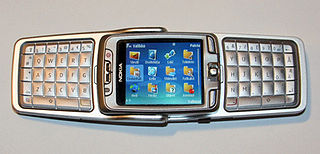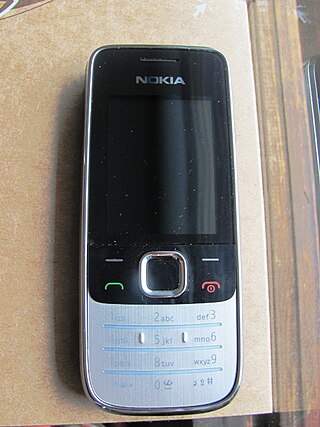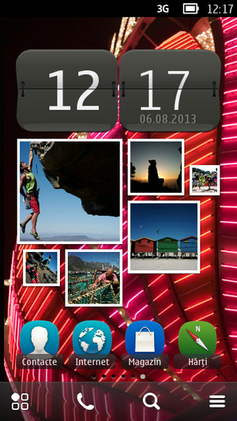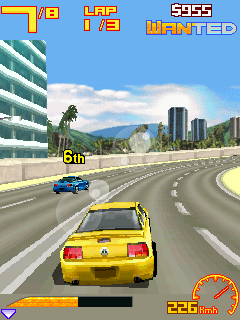Java Platform, Micro Edition or Java ME is a computing platform for development and deployment of portable code for embedded and mobile devices. Java ME was formerly known as Java 2 Platform, Micro Edition or J2ME.

The S60 Platform was a software platform for smartphones that runs on top of the Symbian operating system. It was created by Nokia based on the 'Pearl' user interface from Symbian Ltd. It was introduced at COMDEX in November 2001 and first shipped with the Nokia 7650 smartphone. The platform has since seen 5 updated editions. Series 60 was renamed to S60 in November 2005.
Mobile Information Device Profile (MIDP) is a specification published for the use of Java on embedded devices such as mobile phones and PDAs. MIDP is part of the Java Platform, Micro Edition framework and sits on top of Connected Limited Device Configuration (CLDC), a set of lower level programming interfaces. MIDP was developed under the Java Community Process. The first MIDP devices were launched in April 2001.
The Connected Limited Device Configuration (CLDC) is a specification of a framework for Java ME applications describing the basic set of libraries and virtual-machine features that must be present in an implementation. The CLDC is combined with one or more profiles to give developers a platform for building applications on embedded devices with very limited resources such as pagers and mobile phones. The CLDC was developed under the Java Community Process as JSR 30 and JSR 139.

The Nokia N70 is a 3G mobile phone from Nokia. It was announced as part of the Nokia's new line of multimedia smartphones, the Nseries, on 27 April 2005. It started shipping in September 2005. It runs on the S60 2nd Edition, Feature Pack 3 on Symbian v8.1 operating system. It was succeeded by the Nokia N73. The N70 was popular and sold well.
The Mobile Media API (MMAPI) is an API specification for the Java ME platform CDC and CLDC devices such as mobile phones. Depending on how it is implemented, the APIs allow applications to play and record sounds and video, and to capture still images. MMAPI was developed under the Java Community Process as JSR 135.
Nokia Browser for Symbian was the default web browser for the S60 and Symbian mobile phone platform. The browser is based on a port of Apple Inc.'s open-source WebCore and JavaScriptCore frameworks which form the WebKit rendering engine that Apple uses in its Safari Web browser.

The Nokia 3250 is a mobile phone running Symbian OS v9.1, announced on 26 September 2005. It features a unique 'twist' design that transforms the traditional phone keypad into a camera and dedicated music control keys. It was marketed as a music phone and can store up to 2 gigabytes of music and other data thanks to a microSD memory card slot, and features a two-megapixel camera as well as other smartphone capabilities.

The Nokia E70 is a candybar/fold keyboard-type mobile phone from the Eseries range, announced in October 2005 and released in May 2006. There are two models of this phone, the E70-1 for the world market with tri-band GSM and UMTS, and the E70-2 for the Americas with tri-band GSM and EDGE packet data capability. Both models use the S60 platform 3rd Edition on top of Symbian OS version 9.1.
OpenSL ES is a royalty-free, cross-platform, hardware-accelerated, C-language audio API for 2D and 3D audio. It provides access to features such as 3D positional audio and MIDI playback. It is made for developers in the mobile and gaming industry and is working toward allowing for easy porting of applications across multiple platforms.
The Location API for Java ME is a compact and generic Java 2 ME API that produces information about the device's present physical location to Java applications. This API can be optionally supported by mobile phone and PDA manufacturers, with the minimum Java platform required for this API being CLDC v1.1.

The Nokia 6120 classic is a mid-range mobile phone from Nokia that was announced on 17 April 2007. It runs on Symbian v9.2 with a S60 3rd Edition FP1 user interface.

JavaFX is a software platform for creating and delivering desktop applications, as well as rich web applications that can run across a wide variety of devices. JavaFX has support for desktop computers and web browsers on Microsoft Windows, Linux, and macOS, as well as mobile devices running iOS and Android, through Gluon Mobile.

The Samsung GT-i8510 is a Symbian OS mobile phone produced by Samsung Electronics, announced on 30 July 2008 and released in late 2008. The Innov8's functions include those of a camera phone and portable media player, including an 8-megapixel camera with Dual LED and Schneider-Kreuznach optics.

The Nokia 5320 XpressMusic is a Symbian OS S60 mobile phone, released by Nokia in 2008 as a part of their XpressMusic line of portable devices. The phone has a rugged candybar body with outlined keypads. It emphasizes music and multimedia playback. Among its highlights are a dedicated 3D audio chip for better sound quality, 24 hours of music playback, a 3.5 mm audio jack, N-Gage compatibility, and music/gaming keys. At the time of release the phone cost $220 in the U.S., European and Asian markets.

The Nokia 2730 classic is a Nokia Quad-band GSM/UMTS 3G cell phone that includes a camera, FM radio, Bluetooth, music and video player, as well as several internet-based applications.

Symbian was a mobile operating system (OS) and computing platform designed for smartphones. It was originally developed as a proprietary software OS for personal digital assistants in 1998 by the Symbian Ltd. consortium. Symbian OS is a descendant of Psion's EPOC, and was released exclusively on ARM processors, although an unreleased x86 port existed. Symbian was used by many major mobile phone brands, like Samsung, Motorola, Sony Ericsson, and above all by Nokia. It was also prevalent in Japan by brands including Fujitsu, Sharp and Mitsubishi. As a pioneer that established the smartphone industry, it was the most popular smartphone OS on a worldwide average until the end of 2010, at a time when smartphones were in limited use, when it was overtaken by iOS and Android. It was notably less popular in North America.

The Mobile 3D Graphics API, commonly referred to as M3G, is a specification defining an API for writing Java programs that produce 3D computer graphics. It extends the capabilities of the Java ME, a version of the Java platform tailored for embedded devices such as mobile phones and PDAs. The object-oriented interface consists of 30 classes that can be used to draw complex animated three-dimensional scenes. M3G was developed under the Java Community Process as JSR 184. As of 2007, the current version of M3G is 1.1, but version 2.0 is in development as JSR 297.
Vuforia is an augmented reality software development kit (SDK) for mobile devices that enables the creation of augmented reality applications. It uses computer vision technology to recognize and track planar images and 3D objects in real time. This image registration capability enables developers to position and orient virtual objects, such as 3D models and other media, in relation to real world objects when they are viewed through the camera of a mobile device. The virtual object then tracks the position and orientation of the image in real-time so that the viewer's perspective on the object corresponds with the perspective on the target. It thus appears that the virtual object is a part of the real-world scene.

The Nokia Asha platform is a discontinued mobile operating system (OS) and computing platform designed for low-end borderline smartphones, based on software from Smarterphone which was acquired by Nokia. The platform inherits UI similarities mostly from MeeGo "Harmattan", and replaced Series 40 on Nokia's low-end devices. The user interface design team was headed by Peter Skillman, who had worked previously on webOS and the design of MeeGo for the Nokia N9.











